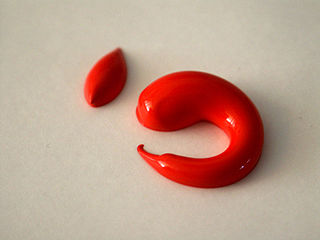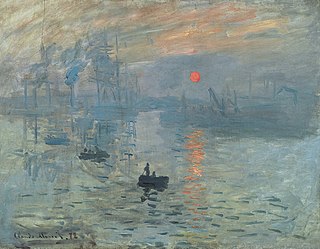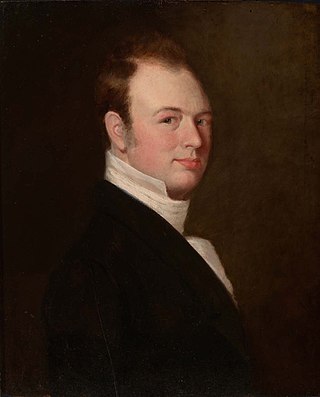Throughout history, forms of art have gone through periodic abrupt changes called artistic revolutions. Movements have come to an end to be replaced by a new movement markedly different in striking ways.

Acrylic paint is a fast-drying paint made of pigment suspended in acrylic polymer emulsion and plasticizers, silicone oils, defoamers, stabilizers, or metal soaps. Most acrylic paints are water-based, but become water-resistant when dry. Depending on how much the paint is diluted with water, or modified with acrylic gels, mediums, or pastes, the finished acrylic painting can resemble a watercolor, a gouache, or an oil painting, or have its own unique characteristics not attainable with other media.

Impressionism was a 19th-century art movement characterized by relatively small, thin, yet visible brush strokes, open composition, emphasis on accurate depiction of light in its changing qualities, ordinary subject matter, unusual visual angles, and inclusion of movement as a crucial element of human perception and experience. Impressionism originated with a group of Paris-based artists whose independent exhibitions brought them to prominence during the 1870s and 1880s.

Oil painting is the process of painting with pigments with a medium of drying oil as the binder. It has been the most common technique for artistic painting on wood panel or canvas for several centuries, spreading from Europe to the rest of the world. The advantages of oil for painting images include "greater flexibility, richer and denser colour, the use of layers, and a wider range from light to dark". But the process is slower, especially when one layer of paint needs to be allowed to dry before another is applied.

En plein air, or plein-air painting, is the act of painting outdoors.

Tempera, also known as egg tempera, is a permanent, fast-drying painting medium consisting of pigments mixed with a water-soluble binder medium, usually glutinous material such as egg yolk. Tempera also refers to the paintings done in this medium. Tempera paintings are very long-lasting, and examples from the first century AD still exist. Egg tempera was a primary method of painting until after 1500 when it was superseded by oil painting. A paint consisting of pigment and binder commonly used in the United States as poster paint is also often referred to as "tempera paint", although the binders in this paint are different from traditional tempera paint.
A football is a ball inflated with air that is used to play one of the various sports known as football. In these games, with some exceptions, goals or points are scored only when the ball enters one of two designated goal-scoring areas; football games involve the two teams each trying to move the ball in opposite directions along the field of play.

Watercolor or watercolour, also aquarelle, is a painting method in which the paints are made of pigments suspended in a water-based solution. Watercolor refers to both the medium and the resulting artwork. Aquarelles painted with water-soluble colored ink instead of modern water colors are called aquarellum atramento by experts. However, this term has now tended to pass out of use.

Oil paint is a type of slow-drying paint that consists of particles of pigment suspended in a drying oil, commonly linseed oil. The viscosity of the paint may be modified by the addition of a solvent such as turpentine or white spirit, and varnish may be added to increase the glossiness of the dried oil paint film. The addition of oil or alkyd medium can also be used to modify the viscosity and drying time of oil paint. Oil paints were first used in Asia as early as the 7th century AD and can be seen in examples of Buddhist paintings in Afghanistan. Oil-based paints made their way to Europe by the 12th century and were used for simple decoration, but oil painting did not begin to be adopted as an artistic medium there until the early 15th century. Common modern applications of oil paint are in finishing and protection of wood in buildings and exposed metal structures such as ships and bridges. Its hard-wearing properties and luminous colors make it desirable for both interior and exterior use on wood and metal. Due to its slow-drying properties, it has recently been used in paint-on-glass animation. The thickness of the coat has considerable bearing on the time required for drying: thin coats of oil paint dry relatively quickly.

Francisco Oller was a Puerto Rican painter. Oller is the only Latin American painter to have played a role in the development of Impressionism. One of the most distinguished transatlantic painters of his day, Oller helped transform painting in the Caribbean.

Body painting is a form of body art where artwork is painted directly onto the human skin. Unlike tattoos and other forms of body art, body painting is temporary, lasting several hours or sometimes up to a few weeks. Body painting that is limited to the face is known as "face painting". Body painting is also referred to as "temporary tattoo". Large scale or full-body painting is more commonly referred to as body painting, while smaller or more detailed work can sometimes be referred to as temporary tattoos.

In urology, a Foley catheter is a flexible tube that a clinician passes through the urethra and into the bladder to drain urine. It is the most common type of indwelling urinary catheter.
19th-century French art was made in France or by French citizens during the following political regimes: Napoleon Bonaparte's Consulate (1799–1804) and Empire (1804–1814), the Restoration under Louis XVIII and Charles X (1814–1830), the July Monarchy under Louis Philippe d'Orléans (1830–1848), the Second Republic (1848–1852), the Second Empire under Napoleon III (1852–1871), and the first decades of the Third Republic (1871–1940).

The bladder pipe is a medieval simplified bagpipe, consisting of an insufflation tube, a bladder (bag) and a chanter, sounded by a double reed, which is fitted into a reed seat at the top of the chanter. The reed, inside the inflated bladder, is sounded continuously, and cannot be tongued. Some bladder pipes were made with a single drone pipe, and reproductions are similar to a loud, continuous crumhorn. The chanter has an outside tenon, at the top, near the reed, which fits into a socket or stock, which is then tied into the bladder.

A rugby ball is an elongated ellipsoidal ball used in both codes of rugby football. Its measurements and weight are specified by World Rugby and the Rugby League International Federation, the governing bodies for both codes, rugby union and rugby league respectively.

Byōbu are Japanese folding screens made from several joined panels, bearing decorative painting and calligraphy, used to separate interiors and enclose private spaces, among other uses.

The bladder fiddle was a folk instrument used throughout Europe and in the Americas. The instrument was originally a simple large stringed fiddle made with a long stick, one or more thick gut strings, and a pig's-bladder resonator. It was bowed with either a notched stick or a horsehair bow.

Painting is the practice of applying paint, pigment, color or other medium to a solid surface. The medium is commonly applied to the base with a brush, but other implements, such as knives, sponges, and airbrushes, can be used.

John Goffe Rand was an American painter and inventor. He lived and worked in Boston, London, and New York. Rand invented and patented the first collapsible artist's paint tube.
The Modern and Contemporary Art Research Initiative is a program started by the Getty Conservation Institute (GCI). It began in 2007 in response to the variety of new materials and technologies being used by contemporary artists in their work, and the lack of known conservation treatments for these new materials. This area was seen as a gap in the field of conservation, but also posed unique challenges when considering the intention of the artist and the physical aging that his or her materials might endure. According to Thomas F. Reese, "Conservators...must enter into the critical spirit of the works themselves if they are to save and transmit not merely decontextualized fragments but their essence to the future."


















